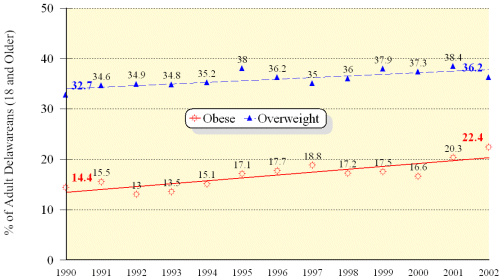Current Suspected Overdose Deaths in Delaware for 2024: Get Help Now!
Find school water testing results and additional resources
Attention Medicaid Participants: Eligibility Renewals Restarted April 1, 2023
Weight and physical activity are closely related factors in health. In fact, obesity and inactivity together are the second leading cause of premature death, illness and disability in the United States. Only smoking kills more people.
Obesity is a risk factor for heart disease, diabetes, some types of cancer, bone and joint disorders, and numerous other health problems. Unfortunately, as our society becomes more sedentary and food more abundant, obesity is also become more prevalent.
Overweight and Obesity Trends
Increasing Among Delaware Adults

Source: Delaware Health and Social Services, Division of Public Health
Behavioral Risk Factor Surveillance System (BRFSS), 1990-2002.
Weight in the BRFSS is estimated using the Body Mass Index (BMI)formula, weight in kilograms divided by height in meters squared. Individuals are considered "overweight" if their BMI is between 25 and 29.9; they are considered "obese" if their BMI is greater than 30.
As shown in the graph above, overweight has increased from 32.7% of Delaware adults in 1990 to 36.2% in 2002. There is a greater increase in the prevalence of obesity in our state. The adult obesity prevalence has increased from 14.4% in 1990 to 22.4% in 2002.
Facts about overweight and obesity in Delaware:
Fruit and vegetable consumption is a good indicator of a healthy diet. Nutrition researchers and dietitians recommend that most adults should eat 5 to 9 servings of a variety of fruits and vegetables every day.
The Delaware BRFSS shows that only a small percentage of adults meet that recommendation.
| Risk Factor | State | Kent | New Castle | Sussex |
|---|---|---|---|---|
| Overweight | 36.2% | 37.1% | 35.3% | 38.9% |
| Obese | 22.4% | 22.9% | 21.6% | 24.9% |
| Eat 5-a-Day Fruits/Veggies | 19.5% | 16.9% | 20.1% | 19.6% |
Source: Delaware Health and Social Services, Division of Public Health, Behavioral Risk Factor Surveillance System (BRFSS), 2002.
For more information on nutrition, visit our page of Tips for Healthy Eating.